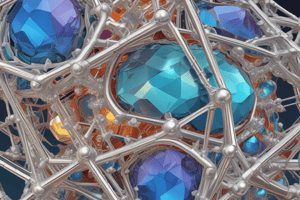Podcast
Questions and Answers
What type of bond holds the ions together in an ionic crystal?
What type of bond holds the ions together in an ionic crystal?
- Electrostatic (correct)
- Molecular
- Covalent
The characteristic that would best identify an ionic crystal is:
The characteristic that would best identify an ionic crystal is:
- Hard and unbreakable
- Dissolves in nonpolar solvents
- Conducts electricity when dissolved in water (correct)
- Low melting point
At the lattice points of an ionic crystal are:
At the lattice points of an ionic crystal are:
- Molecules
- Bonds
- Ions (correct)
- Atoms
Ionic compounds conduct electricity in the solid state.
Ionic compounds conduct electricity in the solid state.
Ionic crystals easily cleave along a plane because of electrostatic repulsion.
Ionic crystals easily cleave along a plane because of electrostatic repulsion.
Ionic crystals are usually liquids at room temperature.
Ionic crystals are usually liquids at room temperature.
The ______ barked.
The ______ barked.
The following are properties of all metals except:
The following are properties of all metals except:
Which one of the following would have metallic bonds?
Which one of the following would have metallic bonds?
Which of the following are properties of all metals and help determine it to be a metal?
Which of the following are properties of all metals and help determine it to be a metal?
Flashcards are hidden until you start studying
Study Notes
Ionic Crystals
- Ionic crystals are held together by electrostatic bonds between ions.
- They are characterized by high melting points, hardness, and brittleness.
- Ionic crystals do not conduct electricity in their solid state, but do conduct when dissolved in water.
Types of Crystalline Solids
- Ionic crystals: composed of positive and negative ions, held together by electrostatic bonds.
- Molecular crystals: composed of molecules, held together by intermolecular forces.
- Network covalent crystals: composed of atoms bonded covalently to neighboring atoms.
- Large carbon chain (LCC) crystals: composed of long chains of carbon atoms.
- Metallic crystals: composed of positive kernels surrounded by a sea of electrons.
Properties of Metals
- Conduct electricity in the solid state.
- Can be hammered into sheets.
- Shine when polished.
- Conduct heat.
- Are typically solids at room temperature.
Metallic Bonds
- Occur in metals, such as Na and Fe.
- Involve the delocalization of electrons.
Properties of Solids
- Ionic crystals: high melting points, hardness, and brittleness.
- Molecular crystals: low melting points, softness, and volatility.
- Network covalent crystals: high melting points, hardness, and brittleness.
- Metallic crystals: high melting points, conductivity, and ductility.
Classification of Substances
- BaCl2: ionic crystal.
- SiC: network covalent crystal.
- H2: molecular crystal.
- Ag: metallic crystal.
- C8H14: molecular crystal.
- C6H9OH: molecular crystal.
- SiO2: network covalent crystal.
- C7H16: molecular crystal.
- Al: metallic crystal.
- NaBr: ionic crystal.
- O2: molecular crystal.
Solubility and Conductivity
- Solubility in water: ionic crystals (e.g., NaCl) and polar molecules (e.g., HOH) are typically soluble.
- Solubility in benzene: nonpolar molecules (e.g., C7H16) are typically soluble.
- Conductivity in solid state: metallic crystals (e.g., Ag) and some ionic crystals (e.g., SiC) are conductors.
- Conductivity in water: ionic crystals (e.g., NaCl) and some polar molecules (e.g., HOH) are conductors.
Studying That Suits You
Use AI to generate personalized quizzes and flashcards to suit your learning preferences.




